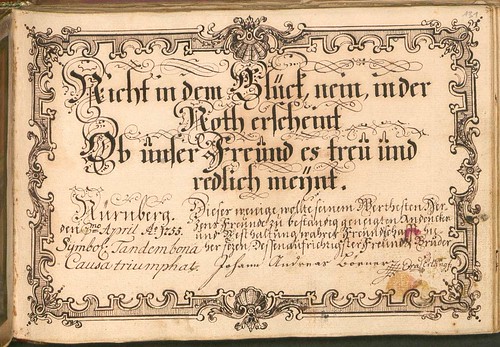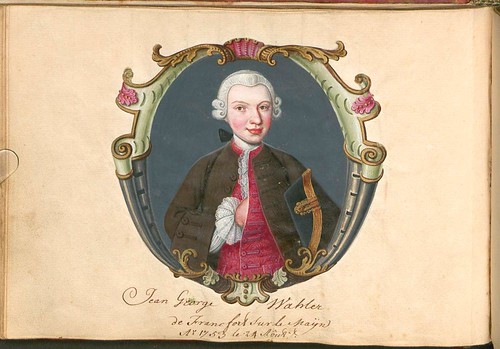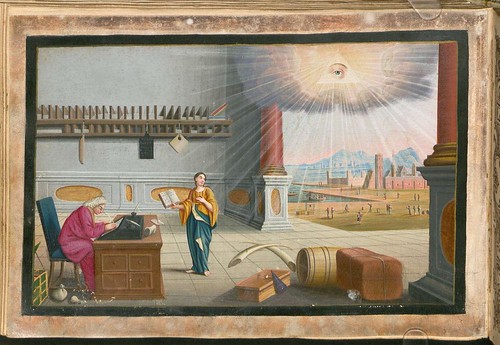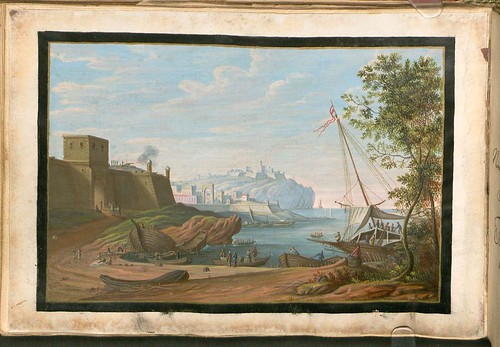














'Stammbuch des Johann Christian Sigmund Mönch aus Jena' - BSB Cgm 9256 is online at Bayerische Staatsbibliothek. [1754 onwards] Click 'Miniaturansicht'. There are about 350 pages: half are blank, many of the remainder have otherwise unremarkable hand-written tributes. All of the above images were spot/background cleaned to at least some extent.
(Stammbuch = Liber Amicorum = Friends' Book)
"Stammbücher appear for the first time in the 16th and 17th centuries in the German- and Dutch-speaking areas of Europe, where it had become fashionable among graduating university students to have one’s personal bible signed by classmates and instructors. Soon inscriptions went beyond simple signatures to include reminiscences of common experiences, good wishes for the future, or a favorite passage from literature or poetry. Publishers foreseeing a lucrative market printed bibles with empty pages and soon also turned out small decorated books with only empty pages.In the archives: Liber Amicorum; Alba Amicorum; Simon Haendel's Stammbuch; Felix and Friends and somewhat related: The Fisch Wappenbuch.
Eventually these albums were not only passed around at graduation but accompanied a student throughout his life, gathering entries from relatives, friends, and important acquaintances. Others also took up the custom, especially those who traveled as part of their training or social upbringing, such as aristocrats, tradesmen, military officers, poets, or musicians. Stammbücher were usually circulated at a time of parting and served the bearer not only as a sentimental remembrance but as a collection of references by association in his pursuit of a professional or social career. Inscriptions were personal, yet frequently included literary quotes, showing the writer’s—and by extension the bearer’s—social and intellectual standing. The messages emphasized values such as intellectual and political freedom, hard work, honesty, forthrightness, self-reliance, and friendship. Good wishes for happiness, health, good fortune, and prosperity were always included."
Source: *“Dies schrieb Dir zur Erinnerung. . .” From Album Amicorum to Autograph Book* by Antje Petty, Director of the Max Kade Institute For German-American Studies at the University of Wisconsin-Madison.



















17 comments :
How interesting to discover the origin of the autograph book - at least in the UK in the 60s, schoolchildren's autograph books were mostly filled with rhymes and drawings and well-wishes by their own contemporaries, rather than signatures of the famous. To realise that the first such books were simply blank pages in Bibles is absolutely fascinating. Thanks.
Awwwww... I adore all their oversized heads! Looks almost like a selection of Marion Peck paintings. Cute!
wow! thx so much! /sms ;-)
If I had the time / patience, it would be interesting to see what more could be found out about some of the people portrayed above.
*snicker* ... OK, on the one hand I'd like to know if anyone knows where the fashion of posing with hand inserted in waistcoat originated and what it was supposed to signify. And on the other hand I'm speculating whether I will resemble the last image when I reach my dotage. I don't know what she's holding, but I'm already accustomed to life with weird (albeit friendly) animals.
Johann, ein großes Sommer! Class of'52 Regeln! Karl
Love your title! LOL! To think we are really not that much more advanced than the 1700's...
Ulla
the aged paper color typography-facebook can't compare, sometimes things can not be improved upon, of course time and history will tell. thanks for the continued visual gifts.
May be it really would have looked like that if Facebook existed at that time. Joy
The only inscription I remember from my high school yearbook is "Hope you're life is like a rool of toliet paper -- long and usefull". I'm pretty sure I got each error verbatim.
It is to weep.
I don't know whether it's worse to be compared to toilet paper or to have the repeated inscription "You are a nice girl, have a fun summer," which translates to "I am and will remain completely ignorant about you." There was, to be sure, "I thought you were quiet but I found out you're not," from another Music Theory student. Quiet, yes; Not Quiet, also yes.
This Blog is GOLD O_O
Peck! Yes, exactly. Thanks Suzanne.
Great posts... thanks for sharing...
@Karla Re: hand inserted in waistcoat. An answer can be found here: http://www.napoleon-series.org/faq/c_hand.html
I quote:
---
[Arline] Miller [in an article entitled, "Re-Dressing Classical Statuary: The Eighteenth-Century 'Hand-in-Waistcoat' Portrait."] points out that the 'hand-in' portrait type appeared with "relentless frequency" during the eighteenth century and became almost a cliched pose in portrait painting. The pose was used so often by portraitists that one was even accused of not knowing how to paint hands. "In real life," Miller observes, "the 'hand-held-in' was a common stance for men of breeding."
---
Interesting. Yes, the hand-in-waistcoat was clearly a portrait cliche at the time... one sees it endlessly... but this is the first I've seen anyone discuss its possible origins or meaning. I'll have to get the Miller article next time I'm on JSTOR (or have a grading-free moment in the library).
Wow, I really like this point of view here. Face book in those days really wasn't so different, other then the technology part of course. Very interesting blog, unique but that's what I expect here anymore!
Post a Comment
Comments are all moderated so don't waste your time spamming: they will never show up.
If you include ANY links that aren't pertinent to the blog post or discussion they will be deleted and a rash will break out in your underwear.
Also: please play the ball and not the person.
Note: only a member of this blog may post a comment.